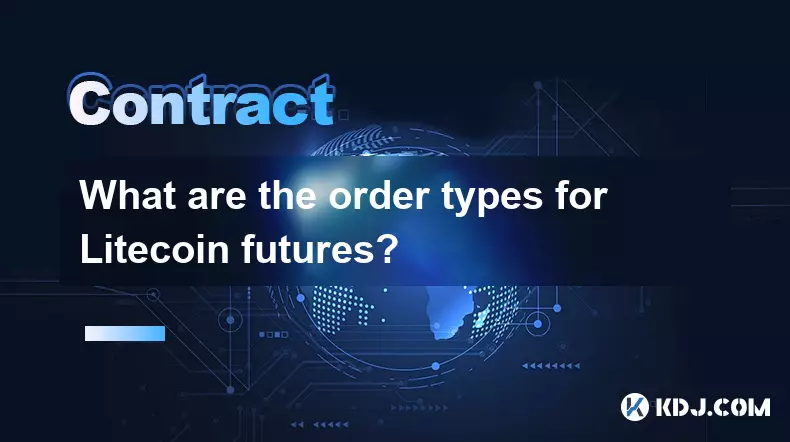-
 bitcoin
bitcoin $122288.232522 USD
0.16% -
 ethereum
ethereum $4480.662914 USD
-0.22% -
 xrp
xrp $2.962747 USD
-2.32% -
 tether
tether $1.000120 USD
-0.05% -
 bnb
bnb $1145.654223 USD
-2.07% -
 solana
solana $227.105217 USD
-1.67% -
 usd-coin
usd-coin $0.999548 USD
-0.02% -
 dogecoin
dogecoin $0.250875 USD
-2.04% -
 tron
tron $0.340654 USD
-0.49% -
 cardano
cardano $0.837968 USD
-2.52% -
 hyperliquid
hyperliquid $48.960449 USD
0.06% -
 chainlink
chainlink $22.049280 USD
-1.33% -
 ethena-usde
ethena-usde $1.000404 USD
0.02% -
 sui
sui $3.586212 USD
0.20% -
 avalanche
avalanche $29.894916 USD
-4.18%
What are the order types for Litecoin futures?
Understanding order types in Litecoin futures—like market, limit, stop-loss, and trailing stops—is crucial for effective trading and risk management.
Sep 29, 2025 at 06:54 pm

Understanding Order Types in Litecoin Futures Trading
1. Market orders are one of the most straightforward order types used in Litecoin futures trading. When a trader places a market order, they instruct their broker or exchange to buy or sell the contract at the best available current price. This type of order ensures immediate execution but does not guarantee the exact price, especially during periods of high volatility. Due to slippage risks, traders must remain cautious when using market orders in fast-moving markets.
2. Limit orders allow traders to set a specific price at which they are willing to enter or exit a position. A buy limit order executes only at the specified price or lower, while a sell limit order triggers at the limit price or higher. This order type provides greater control over entry and exit points, helping traders avoid unfavorable prices. However, there is no guarantee of execution if the market does not reach the designated price level.
3. Stop-loss orders serve as a risk management tool by automatically closing a position when the price reaches a predetermined level. In Litecoin futures, a stop-loss helps protect traders from excessive losses if the market moves against their position. Once the stop price is hit, the order becomes a market order and executes at the next available price. This can be crucial during sudden downturns or flash crashes common in cryptocurrency markets.
4. Stop-limit orders combine features of both stop and limit orders. When the stop price is reached, the order converts into a limit order rather than a market order. This gives traders more control over the execution price but introduces the risk that the order may not fill at all if liquidity is insufficient at the limit price. It's particularly useful for traders who want to avoid slippage while still triggering an order based on price movement.
5. Trailing stop orders dynamically adjust the stop price based on the asset’s price movement. For long positions, the stop price rises as the Litecoin futures price increases, maintaining a set distance below the peak. For short positions, it falls as the price drops. This allows traders to lock in profits while giving room for price fluctuations. The trailing amount can be defined in terms of price points or percentages, offering flexibility depending on trading strategy.
Advanced Order Execution Strategies
1. Fill-or-kill (FOK) orders require that the entire order be executed immediately, or not at all. If full execution isn't possible due to insufficient liquidity, the order gets canceled. This is beneficial for traders who need certainty in execution size and timing, particularly in large trades where partial fills could disrupt strategy.
2. Immediate-or-cancel (IOC) orders demand immediate execution of whatever portion can be filled, with any unfilled part canceled right away. Unlike FOK, IOC allows partial fills. This suits traders aiming to enter or exit quickly without waiting for complete order fulfillment, especially in volatile Litecoin markets.
3. Post-only orders are designed to ensure the trader acts as a liquidity provider rather than a taker. If placing such an order would result in immediate execution (thus taking liquidity), it gets rejected instead. These are commonly used on exchanges that offer fee rebates for adding liquidity, making them cost-effective for active futures traders.
4. Hidden or iceberg orders let traders place large orders without revealing the full size to the market. Only a small visible portion appears in the order book, reducing market impact and preventing other traders from anticipating large moves. While not universally supported, some advanced futures platforms offer these for institutional-grade trading in Litecoin.
Risks and Considerations in Order Placement
1. Slippage remains a critical concern, particularly with market and stop-loss orders. During sharp price swings in Litecoin futures, the difference between expected and actual execution prices can be significant. Traders should monitor historical volatility and choose order types accordingly to minimize unintended exposure.
2. Liquidity varies across different futures contracts and expiration dates. Near-month contracts typically have tighter spreads and better fill rates. Orders placed in low-liquidity environments face higher risks of non-execution or wide bid-ask gaps, especially limit and stop-limit orders.
3. Exchange-specific rules affect how orders behave. Some platforms modify stop orders into market-if-touched variants, while others support complex conditional logic. Understanding the mechanics of the chosen exchange is essential before deploying any order type in live trading.
4. Leverage amplifies both gains and losses in futures trading. Even well-placed orders can lead to substantial losses if market conditions shift rapidly. Proper position sizing and disciplined use of stop mechanisms are necessary to manage downside risk effectively.
Frequently Asked Questions
What is the difference between a stop-loss and a stop-limit order in Litecoin futures?A stop-loss order turns into a market order once the stop price is reached, ensuring execution but not price. A stop-limit order becomes a limit order at the specified price, offering price control but risking non-execution if the market moves too quickly.
Can I modify or cancel a limit order after placing it?Yes, as long as the order has not been fully executed, traders can usually modify the price or quantity, or cancel the order entirely through their trading platform.
Do all exchanges support trailing stop orders for Litecoin futures?No, trailing stop orders are not universally available. Support depends on the exchange’s infrastructure and trading engine capabilities. Major derivatives platforms like BitMEX, Bybit, and OKX typically offer this feature.
Why might a limit order fail to execute even if the price appears to reach my level?Order book dynamics and time priority matter. If multiple orders exist at the same price level, earlier entries get filled first. Additionally, tick size restrictions or fleeting price movements may prevent your order from matching, especially in fast-moving conditions.
Disclaimer:info@kdj.com
The information provided is not trading advice. kdj.com does not assume any responsibility for any investments made based on the information provided in this article. Cryptocurrencies are highly volatile and it is highly recommended that you invest with caution after thorough research!
If you believe that the content used on this website infringes your copyright, please contact us immediately (info@kdj.com) and we will delete it promptly.
- BlockDAG, DOGE, HYPE Sponsorship: Crypto Trends Shaping 2025
- 2025-10-01 00:25:13
- Deutsche Börse and Circle: A StableCoin Adoption Powerhouse in Europe
- 2025-10-01 00:25:13
- BlockDAG's Presale Buzz: Is It the Crypto to Watch in October 2025?
- 2025-10-01 00:30:13
- Bitcoin, Crypto, and IQ: When Genius Meets Digital Gold?
- 2025-10-01 00:30:13
- Stablecoins, American Innovation, and Wallet Tokens: The Next Frontier
- 2025-10-01 00:35:12
- NBU, Coins, and Crypto in Ukraine: A New Yorker's Take
- 2025-10-01 00:45:14
Related knowledge

What is the difference between futures and perpetual contracts for Bitcoin?
Oct 02,2025 at 11:54pm
Understanding Bitcoin Futures Contracts1. Bitcoin futures are derivative instruments that allow traders to speculate on the future price of Bitcoin at...

What is the best time to trade PEPE contracts?
Oct 03,2025 at 11:54am
Understanding PEPE Contract Volatility1. PEPE contracts exhibit extreme price fluctuations due to their meme-based nature and low market cap. Trading ...

What are the common mistakes to avoid with Bitcoincoin contracts?
Oct 03,2025 at 08:54am
Emerging Trends in the Cryptocurrency Market1. Decentralized finance (DeFi) platforms continue to expand their influence across the blockchain ecosyst...

What is the maintenance margin for Bitcoin contracts?
Oct 02,2025 at 01:36am
Decentralized Exchanges Gain Momentum in 20241. Decentralized exchanges (DEXs) have seen a significant rise in trading volume, surpassing centralized ...

How to use technical analysis for trading XRP contracts?
Oct 03,2025 at 01:18pm
Understanding Price Patterns in XRP Futures1. Identifying chart patterns such as triangles, head and shoulders, and double tops or bottoms can provide...

What does "longing" PEPE contracts mean?
Oct 03,2025 at 11:54pm
Understanding Decentralized Exchanges in the Crypto Ecosystem1. Decentralized exchanges (DEXs) operate without a central authority, allowing users to ...

What is the difference between futures and perpetual contracts for Bitcoin?
Oct 02,2025 at 11:54pm
Understanding Bitcoin Futures Contracts1. Bitcoin futures are derivative instruments that allow traders to speculate on the future price of Bitcoin at...

What is the best time to trade PEPE contracts?
Oct 03,2025 at 11:54am
Understanding PEPE Contract Volatility1. PEPE contracts exhibit extreme price fluctuations due to their meme-based nature and low market cap. Trading ...

What are the common mistakes to avoid with Bitcoincoin contracts?
Oct 03,2025 at 08:54am
Emerging Trends in the Cryptocurrency Market1. Decentralized finance (DeFi) platforms continue to expand their influence across the blockchain ecosyst...

What is the maintenance margin for Bitcoin contracts?
Oct 02,2025 at 01:36am
Decentralized Exchanges Gain Momentum in 20241. Decentralized exchanges (DEXs) have seen a significant rise in trading volume, surpassing centralized ...

How to use technical analysis for trading XRP contracts?
Oct 03,2025 at 01:18pm
Understanding Price Patterns in XRP Futures1. Identifying chart patterns such as triangles, head and shoulders, and double tops or bottoms can provide...

What does "longing" PEPE contracts mean?
Oct 03,2025 at 11:54pm
Understanding Decentralized Exchanges in the Crypto Ecosystem1. Decentralized exchanges (DEXs) operate without a central authority, allowing users to ...
See all articles










































































